
It was a Great Los Angeles Walk like no other, but despite this year's socially distanced limitations, we're proud to say that hundreds still hit the pavement on Saturday to explore our city, and back on its ultimate main drag: Wilshire Boulevard.
There was no pre-Walk gathering this year or set start time, so that people could walk when they wanted to and not get bunched up. (We weren't about to be a superspreader event!) So indeed, some folks started walking as early as 7 a.m., while others slept in and joined later in the day or afternoon. Sadly, that means we never got a chance to see everyone, but we did collect some pics of people who we did run into, either in the morning or throughout the day. (And even talked to a couple that first met on the Great Los Angeles Walk a few years ago! Some of this year's participants are above.)
The Great Los Angeles Walk began in 2006 as a hike down Wilshire Boulevard, inspired by the book "Wilshire Boulevard: Grand Concourse of Los Angeles," written by Kevin Roderick with research by J. Eric Lynxwiler. We returned for a second trip in 2010, and now for our 15th edition. But this was our first full Walk down Wilshire in a decade — and quite a bit has changed.
Many buildings are gone, plenty new have sprouted up (or are still in the process of construction). And there's a lot more trash on the street, as the city is in a bit of chaos — some because of the pandemic, and some a lingering problem from even before this year.
From the starting point at Wilshire and Grand (aka One Wilshire), we followed the street's 15.8 miles, passing through MacArthur Park, and seeing sites like Bullock's Wilshire and The Park Plaza Hotel. There were the conservation disappointments (The "Shambassador" high school and the remains of the Brown Derby) and the successes (the Wiltern Theatre). Then there was the shock of seeing what has happend to LACMA, while also enjoying an irreverent art installation there.
We've heard from some of you, and please keep sharing your experience. Thanks to everyone who made all of the trek or some of it, and here's hoping next year we'll be back to a regular, group event. Here are some highlights from the
day (some descriptions by the Los Angeles Conservancy):

One Wilshire, the starting point of this year's Walk. This former office tower now serves as a telecommunications hub.
Of course, a car commercial filming down Grand at Wilshire. When is a car commercial *not* filming in downtown?
One of our favorite utility box murals.
Christmas is under way across Los Angeles.
A busy 110 freeway.
The "Wilshire Special" light, an early street light design in Los Angeles.
Watching over us.
Passionate about Wilshire.
La Parrilla Restaurant: Now a beloved Mexican restaurant, this building's dining rooms ramble through a turreted former home that is one of the oldest remaining buildings on Wilshire Boulevard. The home was built in 1905, when this stretch of Wilshire was still Orange Street.
"Stand and Deliver" mural
Westlake Theater, now Swap Meet
The MacArthur, formerly known as the Park Plaza Hotel. This grand 1925 concrete structure was a private retreat for the Benevolent and Protective Order of Elks, containing 169 hotel rooms along with a gymnasium, pool, and bowling alley.
American Cement Building Lofts. Built in 1961 to house the American Cement Company's headquarters and to showcase the strength, construction advantages, and architectural possibilities of concrete.
A statue of LA Times editor/publisher General Harrison Gray Otis pointing at his former home stands at the entrance to MacArthur Park. It was placed there in 1920 next to a sculpture of a newsboy.
Newsies on Wilshire!
MacArthur Park. This park near downtown went from a mudhole, to a tony recreation spot, to a vibrant place of music, art, and community. Wilshire Boulevard began at the west edge of the park in 1895, and for almost thirty years the park blocked traffic from continuing into downtown. On December 7, 1934, a viaduct across the park connected the original length of Wilshire Boulevard with the last leg of Wilshire going into downtown.
A not-so-friendly message, perhaps, not to use these port-a-potties.
A sign of the times.
Newly designed building art work.
Bullock's Wilshire / Southwestern Law School. The 1929 former Bullock's Wilshire department store building is a spectacular gem that exemplifies the height of the Art Deco style in Los Angeles and beyond.
Ambassador Hotel (Demolished). Opened in 1921 and designed by Myron Hunt, with later renovations by Paul Williams, the Ambassador Hotel was one of Los Angeles’ defining historic sites. It was also home to the Cocoanut Grove nightclub, Los Angeles’ premier night spot for decades; host to six Oscar ceremonies and to every U.S. President from Herbert Hoover to Richard Nixon; and the site of the assassination of Robert F. Kennedy in 1968. Rebuilt as a school.
The Gaylord and HMS Bounty. The thirteen-story Gaylord apartment building opened in 1924 directly across Wilshire from the Ambassador Hotel. Some claim it was named for Henry Gaylord Wilshire, the founder of Wilshire Boulevard.
Brown Derby Dome. An iconic example of the roadside vernacular architecture that was especially popular in California and designed to capture the attention of passing motorists, the flagship location of the Brown Derby was actually built in the shape of a hat.
One of the few remaining signs from the original Ambassador.
Sigh. Wilshire has become quite a garbage pit in places.
Mural at the Line hotel.
RIP Kobe
Eyes on Wilshire
Outside a Korean Restaurant. Mmm, bulgogi!
A new, interesting structure rising next to the Wilshire Boulevard Temple.
Wilshire Colonnade. A monument to L.A. financier Howard F. Ahmanson and the third of Edward Durell Stone's buildings constructed on Wilshire Boulevard, Wilshire Colonnade is among Stone's finest achievements and a worthy tribute to a great patron of L.A. arts and culture.
The Wiltern and Pellissier Building. The distinctive, blue-green terra-cotta complex was designed by Stiles O. Clements of Morgan, Walls & Clements. Narrow windows in the office tower, deeply set between soaring vertical piers, give the illusion of a much taller building than its actual 150 feet (the maximum height permitted by the City at that time).
Maria is interviewed by LA 35.
Bill Murray overlooks Wilshire.
#BlackLivesMatter at the Harbor building. Combining Corporate International and Late Moderne styles, Claud Beelman's Harbor Building (1956) is one of the era's most impressive corporate buildings.
I hope you're right.
Three blind mice.
I heart bandage LA.
'Tis the season.
El Rey Theatre. This beloved Miracle Mile landmark (1936) combines Art Deco and Streamline Moderne styles and retains many original design elements, including its lobby, façade, terrazzo, and brilliant neon sign.
Fruit vendor!
LACMA takes advantage of the pandemic to tear down most of its buildings. When it opened in 1965, the Los Angeles County Museum of Art (LACMA) was the largest new art museum the country had seen in a quarter century. The museum rose on the site of the old adobe and tree-shaded home ranch that the Hancock family donated to the county for a park in 1916. Three original LACMA buildings faced onto Wilshire from a raised plaza, with fountains and a reflecting pool along the boulevard.
Make sure you get to LACMA for Alex Prager's "Farewell, Work Holiday Parties." I'll be posting more on this later.
Still curious how Johnie's Coffee Shop turned into Bernie's.
I'm glad the lettering is gone on this sculpture, meant to convey a record needle. (It's the former BMG headquarters.)
Speaking of Beverly Hills...
... the holidays have arrived.
The Wilshire on Wilshire.
Don Knotts' resting place at the Westwood Memorial cemetery...
... where Hugh Hefner and Marilyn Monroe are side by side?
RIP Anthony Bourdain
Do the Wave?
Wilshire in neon!
Whatever works!
And the end point, the Santa Monica statue at the end of Wilshire, overlooking the ocean. We spent our time exploring this year, since there wasn't an end party like normal. Hopefully next year we'll be back to doing this all together. As usual, it will be the Saturday before Thanksgiving. See you all then!
















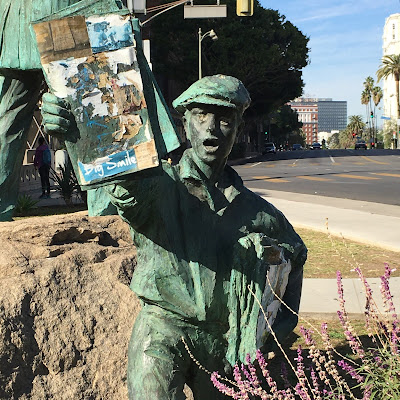






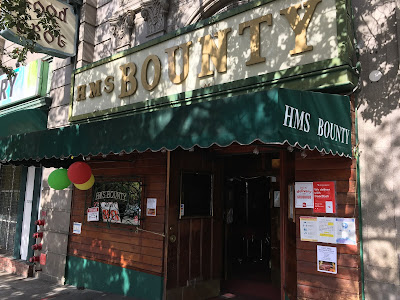













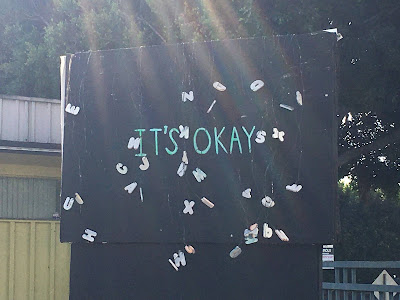
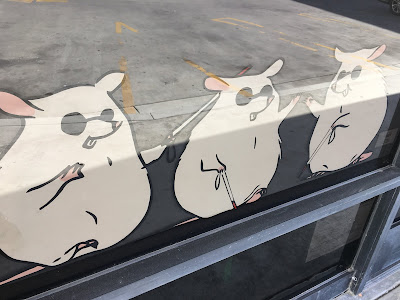
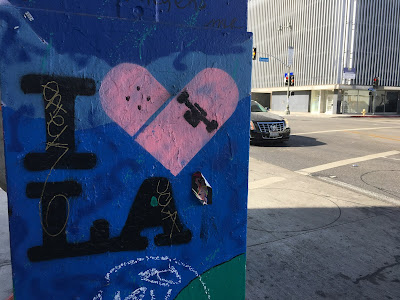















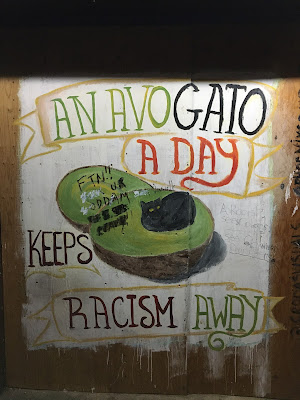

No comments:
Post a Comment